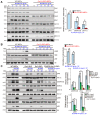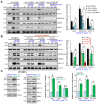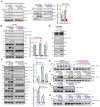Neuronal-driven glioma growth requires Gαi1 and Gαi3
- PMID: 34373757
- PMCID: PMC8343996
- DOI: 10.7150/thno.61452
Neuronal-driven glioma growth requires Gαi1 and Gαi3
Abstract
Neuroligin-3 (NLGN3) is necessary and sufficient to promote glioma cell growth. The recruitment of Gαi1/3 to the ligand-activated receptor tyrosine kinases (RTKs) is essential for mediating oncogenic signaling. Methods: Various genetic strategies were utilized to examine the requirement of Gαi1/3 in NLGN3-driven glioma cell growth. Results: NLGN3-induced Akt-mTORC1 and Erk activation was inhibited by decreasing Gαi1/3 expression. In contrast ectopic Gαi1/3 overexpression enhanced NLGN3-induced signaling. In glioma cells, NLGN3-induced cell growth, proliferation and migration were attenuated by Gαi1/3 depletion with shRNA, but facilitated with Gαi1/3 overexpression. Significantly, Gαi1/3 silencing inhibited orthotopic growth of patient-derived glioma xenografts in mouse brain, whereas forced Gαi1/3-overexpression in primary glioma xenografts significantly enhanced growth. The growth of brain-metastatic human lung cancer cells in mouse brain was largely inhibited with Gαi1/3 silencing. It was however expedited with ectopic Gαi1/3 overexpression. In human glioma Gαi3 upregulation was detected, correlating with poor prognosis. Conclusion: Gαi1/3 mediation of NLGN3-induced signaling is essential for neuronal-driven glioma growth.
Keywords: Gαi1/3; NLGN3; Neuron-glioma communication; Signaling.
© The author(s).
Conflict of interest statement
Competing Interests: The authors have declared that no competing interest exists.
Figures








Similar articles
-
Targeting neuronal activity-regulated neuroligin-3 dependency in high-grade glioma.Nature. 2017 Sep 28;549(7673):533-537. doi: 10.1038/nature24014. Epub 2017 Sep 20. Nature. 2017. PMID: 28959975 Free PMC article.
-
microRNA-200a downregulation in human glioma leads to Gαi1 over-expression, Akt activation, and cell proliferation.Oncogene. 2018 May;37(21):2890-2902. doi: 10.1038/s41388-018-0184-5. Epub 2018 Mar 9. Oncogene. 2018. PMID: 29520106
-
NLGN3 promotes neuroblastoma cell proliferation and growth through activating PI3K/AKT pathway.Eur J Pharmacol. 2019 Aug 15;857:172423. doi: 10.1016/j.ejphar.2019.172423. Epub 2019 May 28. Eur J Pharmacol. 2019. PMID: 31150649
-
Neuron-secreted NLGN3 ameliorates ischemic brain injury via activating Gαi1/3-Akt signaling.Cell Death Dis. 2023 Oct 25;14(10):700. doi: 10.1038/s41419-023-06219-8. Cell Death Dis. 2023. PMID: 37880221 Free PMC article.
-
Requirement of Gαi1/3-Gab1 signaling complex for keratinocyte growth factor-induced PI3K-AKT-mTORC1 activation.J Invest Dermatol. 2015 Jan;135(1):181-191. doi: 10.1038/jid.2014.326. Epub 2014 Jul 31. J Invest Dermatol. 2015. PMID: 25078664
Cited by
-
Gαi1/3 mediate Netrin-1-CD146-activated signaling and angiogenesis.Theranostics. 2023 Apr 17;13(7):2319-2336. doi: 10.7150/thno.80749. eCollection 2023. Theranostics. 2023. PMID: 37153740 Free PMC article.
-
YME1L overexpression exerts pro-tumorigenic activity in glioma by promoting Gαi1 expression and Akt activation.Protein Cell. 2023 Apr 13;14(3):223-229. doi: 10.1093/procel/pwac011. Protein Cell. 2023. PMID: 37051674 Free PMC article. No abstract available.
-
COL8A1 overexpression promotes glioma cell growth by activating focal adhesion kinase signaling cascade.NPJ Precis Oncol. 2024 Nov 22;8(1):273. doi: 10.1038/s41698-024-00762-z. NPJ Precis Oncol. 2024. PMID: 39578589 Free PMC article.
-
Neuromodulation for Brain Tumors: Myth or Reality? A Narrative Review.Int J Mol Sci. 2023 Jul 21;24(14):11738. doi: 10.3390/ijms241411738. Int J Mol Sci. 2023. PMID: 37511496 Free PMC article. Review.
-
Targeting the postsynaptic scaffolding protein PSD-95 enhances BDNF signaling to mitigate depression-like behaviors in mice.Sci Signal. 2024 Apr 30;17(834):eadn4556. doi: 10.1126/scisignal.adn4556. Epub 2024 Apr 30. Sci Signal. 2024. PMID: 38687826 Free PMC article.
References
-
- Siegel RL, Miller KD, Jemal A. Cancer statistics, 2018. CA Cancer J Clin. 2018;68:7–30. - PubMed
-
- Siegel RL, Miller KD, Jemal A. Cancer Statistics, 2017. CA Cancer J Clin. 2017;67:7–30. - PubMed
-
- Reardon DA, Wen PY. Glioma in 2014: unravelling tumour heterogeneity-implications for therapy. Nat Rev Clin Oncol. 2015;12:69–70. - PubMed
-
- Wen PY, Reardon DA. Neuro-oncology in 2015: Progress in glioma diagnosis, classification and treatment. Nat Rev Neurol. 2016;12:69–70. - PubMed
-
- Kwiatkowska A, Symons M. Signaling Determinants of Glioma Cell Invasion. Adv Exp Med Biol. 2020;1202:129–49. - PubMed
Publication types
MeSH terms
Substances
LinkOut - more resources
Full Text Sources
Miscellaneous

